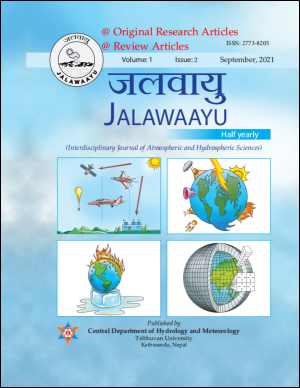Spatial Pattern of Precipitation in GPM-Era Satellite Products against Rain Gauge Measurements over Nepal
DOI:
https://doi.org/10.3126/jalawaayu.v1i2.41009Keywords:
Satellite Precipation, IMERG, GSMaP, Nepal, MountainsAbstract
Precipitation in a mountainous region is highly variable due to the complex terrain. Satellite-based precipitation estimates are potential alternatives to gauge measurements in these regions, as these typical measurements are not available or are scarce in high elevation areas. However, the accuracy of these gridded precipitation datasets need to be addressed before further usage. In this study, an evaluation of the spatial precipitation pattern in satellite-based precipitation products is provided, including satellite-only (Integrated Multi satellite Retrievals for GPM IMERG-UCORR and Global Satellite Mapping of Precipitation (GSMaP-MVK) and gauge calibrated (IMERG-CORR and GSMaP-Gauge) products, with a spatial resolution of 0.1°, which is compared to 387-gauge measurements in Nepal from April 2014 to December 2016. The major results are as follows: (1) The gauge calibrated version 5 IMERG-CORR and version 6 GSMaP-Gauge are relatively better than the satellite-only datasets, although they all underestimate the observed precipitation. (2) The daily gauge calibrated GSMaP-Gauge performs fairly well in low and mid-elevation areas, whereas the monthly gauge calibrated IMERG-C performs better in high-elevation areas. (3) For the daily time scale, IMERG-CORR shows a better ability to detect the true precipitation (higher Probability of Detection (POD)) and (lowest False Alarm Ratio (FAR)) events among all datasets. However, all four satellite-based precipitation datasets accurately detect (Critical Success Index (CSI) >40%) precipitation and no-precipitation events. The results of this work provide the systematic quantification of IMERG and GSMaP of satellite precipitation products over Nepal using station observations and delivers a helpful statistical basis for the selection of these datasets for future scientific research.
Downloads
Downloads
Published
How to Cite
Issue
Section
License

This work is licensed under a Creative Commons Attribution 4.0 International License.
Copyright © of the articles is held by the authors.

